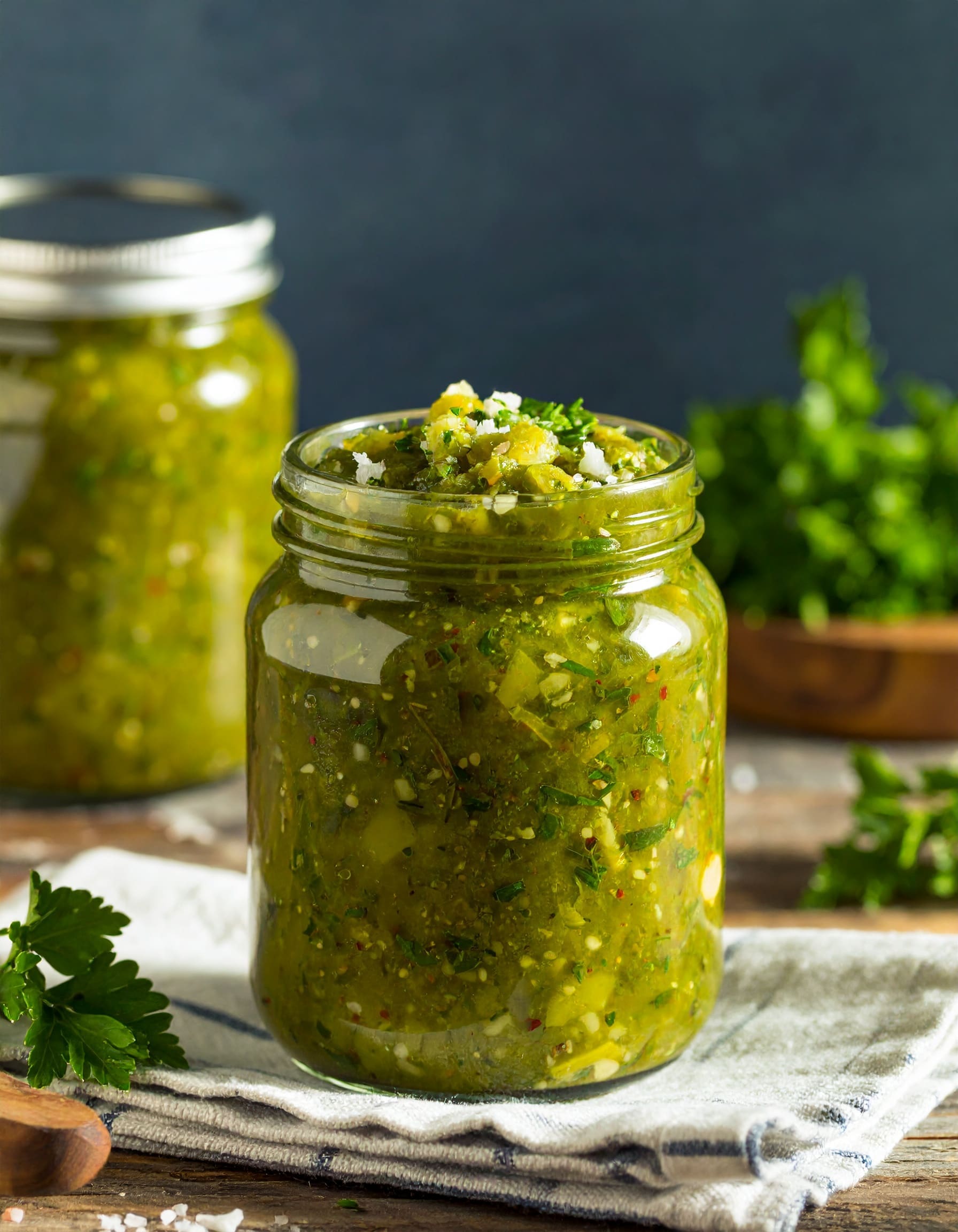
We've concocted a quick homemade relish recipe straight from the family book: a beautiful, easy-to-make recipe handed down from my grandmother. It's the perfect accompaniment to your other condiments.
Visit relisha pickle-based condiment, is a cooked and marinated dish of chopped vegetables, fruits or herbs, often used to enhance the flavors of a main food. Common examples include chutneys and North American relish, a pickled cucumber jam that traditionally accompanies hot dogs. In North America, the term "relish" often refers to a variety of finely chopped, pickled cucumber-based relishes, such as pickle relish, dill relish or sweet relish.
Visit kyopolou (Кьопоолу), a Balkan relish, is a preparation based on red peppers, eggplant and garlic. Relishes usually consist of visible chunks of vegetables or fruit in a sauce, although this is secondary to the solid ingredients. Herbs and seeds may also be added, and some relishes, like the chermoulaRelishes are made entirely from herbs and spices. Relish can be made from a single type of vegetable or fruit, or a mixture of several, cut more or less finely. Its texture varies according to how it's cut, but it's generally less smooth than a condiment like ketchup. Relish has a pronounced flavor, which complements or enriches the taste of the foods with which it is served.
Visit house relishis a must for adding a burst of flavor to any dish. Whether accompanying hot dogs, hamburgers, sandwiches or grilled meats, it adds that touch of acidity, sweetness and crunch that instantly transforms a meal. Unlike industrial versions, often rich in preservatives and sugar, homemade relish lets you control the ingredients and adjust the flavors to your taste. By making your own relish, you can combine fresh vegetables and spices to create a tasty, versatile condiment that will quickly become a kitchen essential. Not only is it simple to prepare, but it also keeps very well, allowing you to enjoy its unique taste for several weeks. Ready to delight your taste buds, the homemade relish recipe is easy to follow and deliciously authentic.
4 medium cucumbers (approx. 800 g), seeded and finely chopped
2 red peppers (about 200 g), finely chopped
1 large onion (about 150 g), finely chopped
2 stalks celery (approx. 100 g), finely chopped
150 g powdered sugar
250 ml white vinegar
2 tablespoons mustard powder
1 tablespoon turmeric
1 tablespoon mustard seeds
1 tablespoon salt
1. Preparing vegetables
Start by carefully washing the cucumbers, red peppers, onion and celery. Once washed, remove the seeds from the cucumbers and peppers. Next, finely chop all the vegetables. For a more homogenous texture, you can use a food processor, but be careful not to puree the vegetables. They should retain the crunchy texture characteristic of homemade relish.
Once the vegetables have been chopped, place in a large bowl and sprinkle with salt. Mix well to distribute the salt evenly. Leave to stand for about 1 hour. This step allows the vegetables to drain, i.e. to remove some of their water. After an hour, rinse the vegetables in cold water to remove excess salt, then drain well. You can press the vegetables in a clean cloth to remove any remaining water, which is important to prevent the homemade relish from being too runny.
2. Preparing the relish
In a large saucepan, combine the white vinegar, sugar, mustard powder, turmeric and mustard seeds. Bring to the boil over medium heat, stirring regularly to dissolve the sugar and integrate the spices. Turmeric is the key ingredient that gives the homemade relish its bright yellow color and subtly spicy flavor.
Once the mixture has come to the boil, add the drained vegetables to the pan. Reduce the heat to low and simmer for about 1 hour, stirring occasionally. This slow cooking allows the vegetables to absorb all the flavors of the spices and vinegar, while developing their own natural sweetness. The homemade relish should thicken slightly during cooking, reaching the perfect consistency for topping your favorite dishes.
3. Potting
While your homemade relish is simmering, prepare your glass jars. Sterilization is essential to ensure optimum preservation of your homemade relish. To do this, immerse the jars and their lids in a large pot of boiling water for at least 10 minutes. Let them air-dry on a clean cloth.
Once cooked, pour the hot homemade relish into the sterilized jars, leaving a space of about 1 cm at the top. Close the jars tightly with the lids. You can then process the jars in a water bath to prolong their shelf life, but this is not necessary if you plan to consume the homemade relish within a few weeks.
4. Conservation
Allow jars of homemade relish to cool completely to room temperature before storing in a cool, dark place. Homemade relish will keep for several months, but once opened should be refrigerated and consumed within two weeks.
Homemade relish is a versatile, flavorful condiment that adds a touch of sparkle to a multitude of dishes. Preparing your own homemade relish allows you not only to control the quality of the ingredients, but also to experiment with flavors according to your personal tastes. Whether it's to accompany a summer barbecue, liven up a simple sandwich or add an original touch to your everyday dishes, homemade relish will always find its place. What's more, the gift of a jar of homemade relish is a wonderful gift that will delight your loved ones. With this recipe for homemade relish, you've got everything you need to make a delicious, healthy, homemade condiment.
Country of origin
Relish, as we know it today, has its roots in North America, where it became a popular condiment to accompany hot dogs and other grilled meats. However, its origins can be traced back to vegetable preservation practices in European countries, notably Germany and Poland. These practices crossed the Atlantic with immigrants, evolving over time to become the homemade relish we know today. By preparing this recipe for homemade relish, you're joining a long tradition of preserving and enhancing vegetables, while adding a touch of freshness to your cooking.
Sponsor
Advertising
Sweet and spicy relish Add a pinch of cayenne pepper or a small chopped red pepper.
Dill version Add 1 tablespoon of fresh or dried dill for a more herbaceous touch.
Pickle Relish For example: replace some of the cucumbers with chopped gherkins.
Crunchy relish Add 1 grated carrot for a more varied texture.
Smoke relish Stir in 1 teaspoon smoked paprika.
Lemon relish Add the zest of one lemon and 1 tablespoon lemon juice for extra freshness.
Spicy relish Replace red bell pepper with green bell pepper and add 1/2 teaspoon black pepper.
Asian relish Add a little grated fresh ginger and a drizzle of soy sauce (1 tablespoon).
Garlic Relish Add 1 or 2 finely chopped garlic cloves.
Low-fat mild relish Reduce the amount of sugar by half and replace with honey.

Never miss a good recipe again
Advertising
MENU
revenue types
Copyright © 2025
4 medium cucumbers (approx. 800 g), seeded and finely chopped
2 red peppers (about 200 g), finely chopped
1 large onion (about 150 g), finely chopped
2 stalks celery (approx. 100 g), finely chopped
150 g powdered sugar
250 ml white vinegar
2 tablespoons mustard powder
1 tablespoon turmeric
1 tablespoon mustard seeds
1 tablespoon salt
1. Preparing vegetables
Start by carefully washing the cucumbers, red peppers, onion and celery. Once washed, remove the seeds from the cucumbers and peppers. Next, finely chop all the vegetables. For a more homogenous texture, you can use a food processor, but be careful not to puree the vegetables. They should retain the crunchy texture characteristic of homemade relish.
Once the vegetables have been chopped, place in a large bowl and sprinkle with salt. Mix well to distribute the salt evenly. Leave to stand for about 1 hour. This step allows the vegetables to drain, i.e. to remove some of their water. After an hour, rinse the vegetables in cold water to remove excess salt, then drain well. You can press the vegetables in a clean cloth to remove any remaining water, which is important to prevent the homemade relish from being too runny.
2. Preparing the relish
In a large saucepan, combine the white vinegar, sugar, mustard powder, turmeric and mustard seeds. Bring to the boil over medium heat, stirring regularly to dissolve the sugar and integrate the spices. Turmeric is the key ingredient that gives the homemade relish its bright yellow color and subtly spicy flavor.
Once the mixture has come to the boil, add the drained vegetables to the pan. Reduce the heat to low and simmer for about 1 hour, stirring occasionally. This slow cooking allows the vegetables to absorb all the flavors of the spices and vinegar, while developing their own natural sweetness. The homemade relish should thicken slightly during cooking, reaching the perfect consistency for topping your favorite dishes.
3. Potting
While your homemade relish is simmering, prepare your glass jars. Sterilization is essential to ensure optimum preservation of your homemade relish. To do this, immerse the jars and their lids in a large pot of boiling water for at least 10 minutes. Let them air-dry on a clean cloth.
Once cooked, pour the hot homemade relish into the sterilized jars, leaving a space of about 1 cm at the top. Close the jars tightly with the lids. You can then process the jars in a water bath to prolong their shelf life, but this is not necessary if you plan to consume the homemade relish within a few weeks.
4. Conservation
Allow jars of homemade relish to cool completely to room temperature before storing in a cool, dark place. Homemade relish will keep for several months, but once opened should be refrigerated and consumed within two weeks.